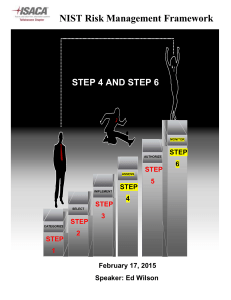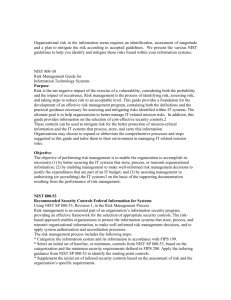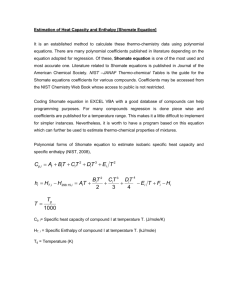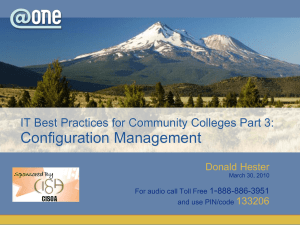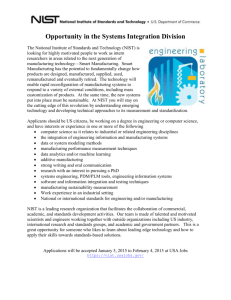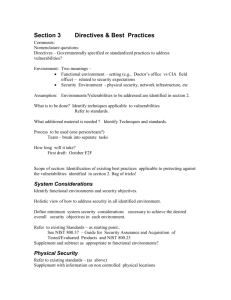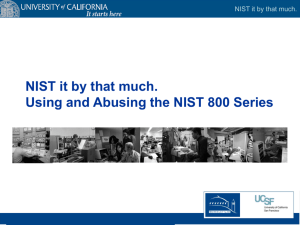National Information Assurance Partnership
advertisement
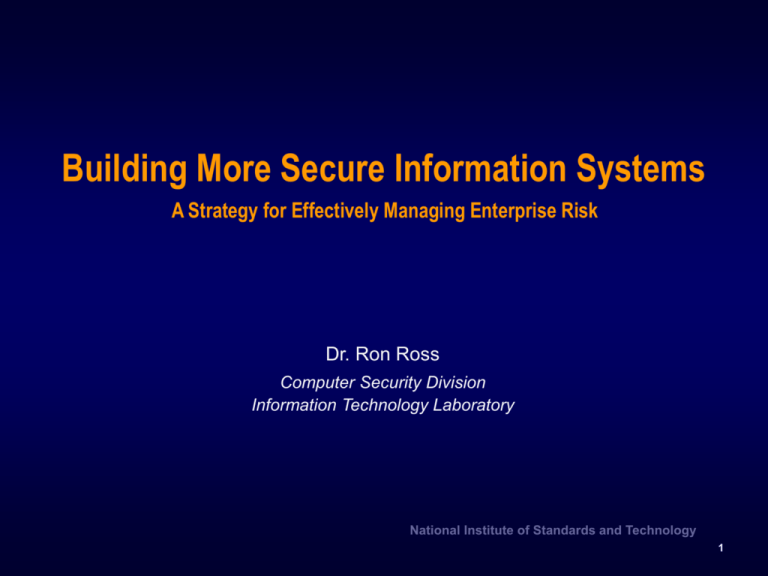
Building More Secure Information Systems A Strategy for Effectively Managing Enterprise Risk Dr. Ron Ross Computer Security Division Information Technology Laboratory National Institute of Standards and Technology 1 Why Standardization? Security Visibility Among Business/Mission Partners Organization One Information System Organization Two Business / Mission Information Flow System Security Plan Security Assessment Report Information System System Security Plan Security Information Security Assessment Report Plan of Action and Milestones Plan of Action and Milestones Determining the risk to the first organization’s operations and assets and the acceptability of such risk Determining the risk to the second organization’s operations and assets and the acceptability of such risk The objective is to achieve visibility into prospective business/mission partners information security programs BEFORE critical/sensitive communications begin…establishing levels of security due diligence. National Institute of Standards and Technology 2 Information Security Program Links in the Security Chain: Management, Operational, and Technical Controls Risk assessment Security planning Security policies and procedures Contingency planning Incident response planning Security awareness and training Physical security Personnel security Certification, accreditation, and security assessments Access control mechanisms Identification & authentication mechanisms (Biometrics, tokens, passwords) Audit mechanisms Encryption mechanisms Firewalls and network security mechanisms Intrusion detection systems Security configuration settings Anti-viral software Smart cards Adversaries attack the weakest link…where is yours? National Institute of Standards and Technology 3 Managing Enterprise Risk Key activities in managing enterprise-level risk—risk resulting from the operation of an information system: Categorize the information system Select set of minimum (baseline) security controls Refine the security control set based on risk assessment Document security controls in system security plan Implement the security controls in the information system Assess the security controls Determine agency-level risk and risk acceptability Authorize information system operation Monitor security controls on a continuous basis National Institute of Standards and Technology 4 Managing Enterprise Risk The Framework SP 800-53 / FIPS 200 Starting Point Security Control Selection Selects minimum security controls (i.e., safeguards and countermeasures) planned or in place to protect the information system FIPS 199 / SP 800-60 Security Categorization Defines category of information system according to potential impact of loss SP 800-37 Security Control Monitoring Continuously tracks changes to the information system that may affect security controls and assesses control effectiveness SP 800-53 / FIPS 200 / SP 800-30 SP 800-37 Security Control Refinement System Authorization Uses risk assessment to adjust minimum control set based on local conditions, required threat coverage, and specific agency requirements Determines risk to agency operations, agency assets, or individuals and, if acceptable, authorizes information system processing SP 800-18 Security Control Documentation In system security plan, provides a an overview of the security requirements for the information system and documents the security controls planned or in place SP 800-70 Security Control Implementation Implements security controls in new or legacy information systems; implements security configuration checklists SP 800-53A / SP 800-37 Security Control Assessment Determines extent to which the security controls are implemented correctly, operating as intended, and producing desired outcome with respect to meeting security requirements National Institute of Standards and Technology 5 The Golden Rules Building an Effective Enterprise Information Security Program Develop an enterprise-wide information security strategy and game plan Get corporate “buy in” for the enterprise information security program—effective programs start at the top Build information security into the infrastructure of the enterprise Establish level of “due diligence” for information security Focus initially on mission/business case impacts—bring in threat information only when specific and credible National Institute of Standards and Technology 6 The Golden Rules Building an Effective Enterprise Information Security Program Create a balanced information security program with management, operational, and technical security controls Employ a solid foundation of security controls first, then build on that foundation guided by an assessment of risk Avoid complicated and expensive risk assessments that rely on flawed assumptions or unverifiable data Harden the target; place multiple barriers between the adversary and enterprise information systems Be a good consumer—beware of vendors trying to sell “single point solutions” for enterprise security problems National Institute of Standards and Technology 7 The Golden Rules Building an Effective Enterprise Information Security Program Don’t be overwhelmed with the enormity or complexity of the information security problem—take one step at a time and build on small successes Don’t tolerate indifference to enterprise information security problems And finally… Manage enterprise risk—don’t try to avoid it! National Institute of Standards and Technology 8 NIST Guidance on HIPAA Special Publication 800-66 An Introductory Resource Guide for Implementing the Health Insurance Portability and Accountability Act (HIPAA) Security Rule Initial Public Draft, May 2004 National Institute of Standards and Technology 9 FISMA Implementation Project Standards and Guidelines FIPS Publication 199 (Security Categorization) NIST Special Publication 800-37 (Certification & Accreditation) NIST Special Publication 800-53 (Recommended Security Controls) NIST Special Publication 800-53A (Security Control Assessment) NIST Special Publication 800-59 (National Security Systems) NIST Special Publication 800-60 (Security Category Mapping) FIPS Publication 200 (Minimum Security Controls) National Institute of Standards and Technology 10 Contact Information 100 Bureau Drive Mailstop 8930 Gaithersburg, MD USA 20899-8930 Project Leader Administrative Support Dr. Ron Ross (301) 975-5390 ron.ross@nist.gov Peggy Himes (301) 975-2489 peggy.himes@nist.gov Senior Information Security Researchers and Technical Support Marianne Swanson (301) 975-3293 marianne.swanson@nist.gov Dr. Stu Katzke (301) 975-4768 skatzke@nist.gov Pat Toth (301) 975-5140 patricia.toth@nist.gov Arnold Johnson (301) 975-3247 arnold.johnson@nist.gov Curt Barker (301) 975-4768 wbarker@nist.gov Information and Feedback Web: csrc.nist.gov/sec-cert Comments: sec-cert@nist.gov National Institute of Standards and Technology 11
